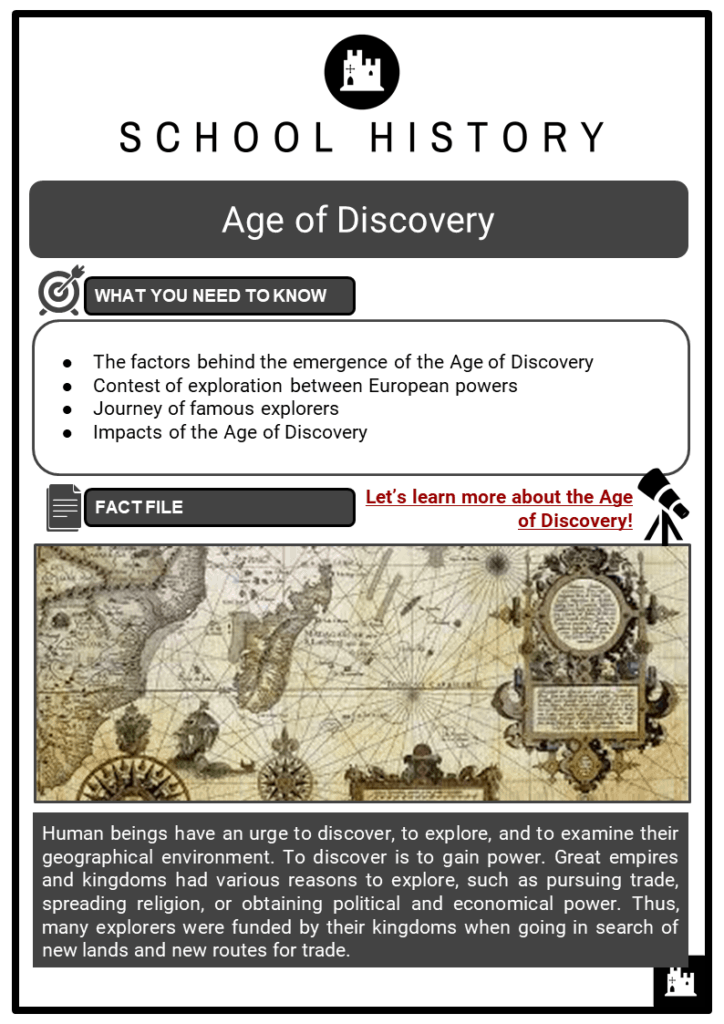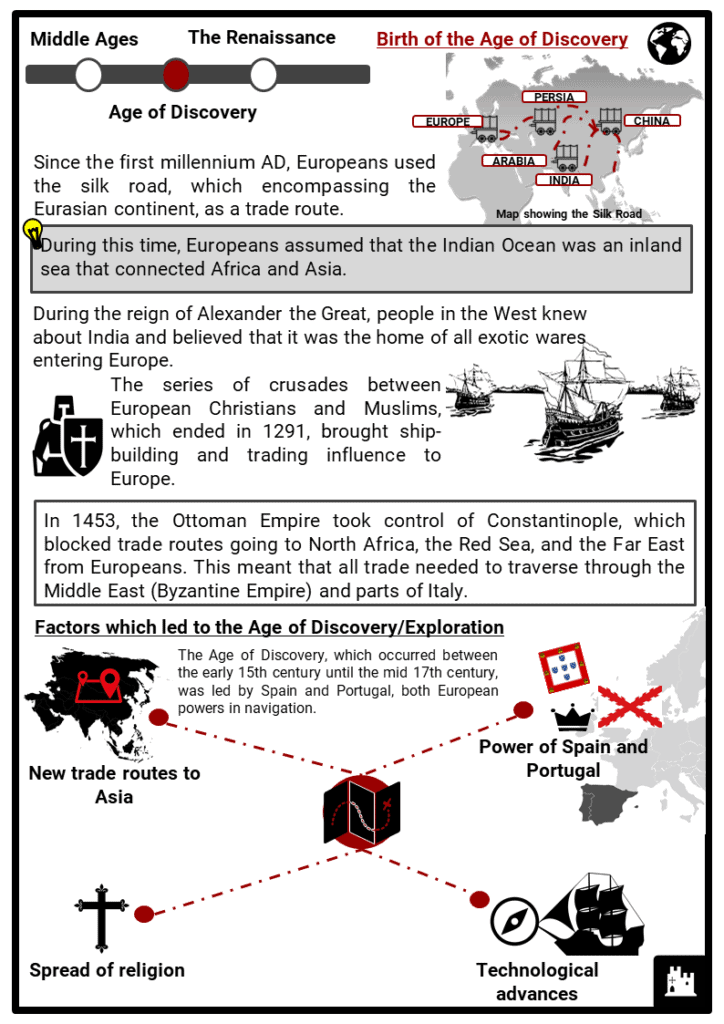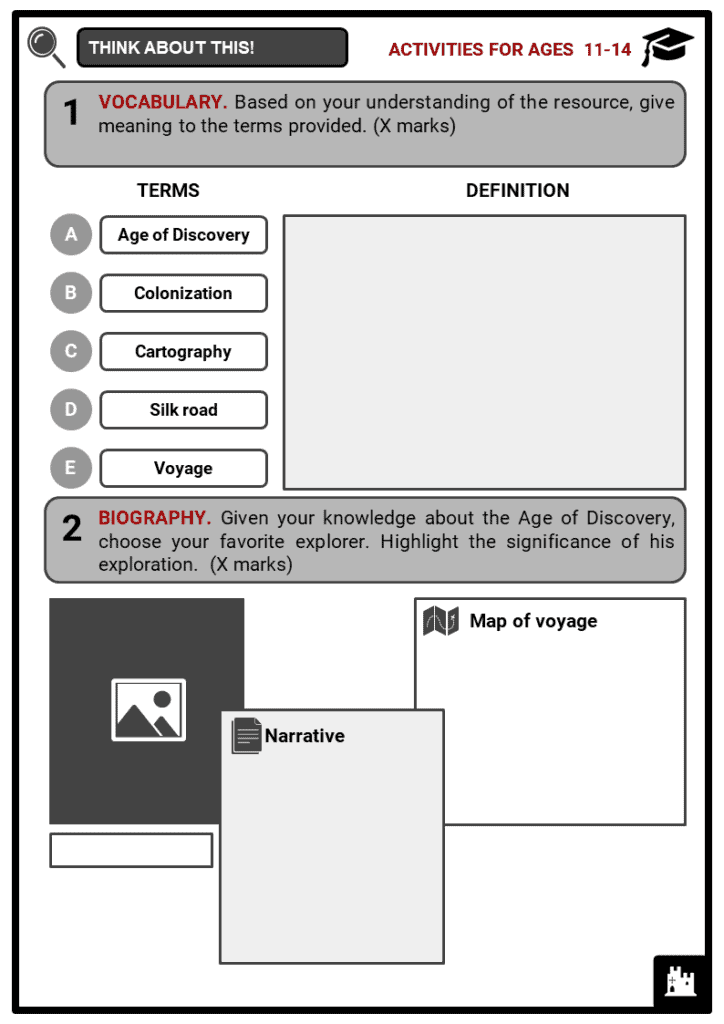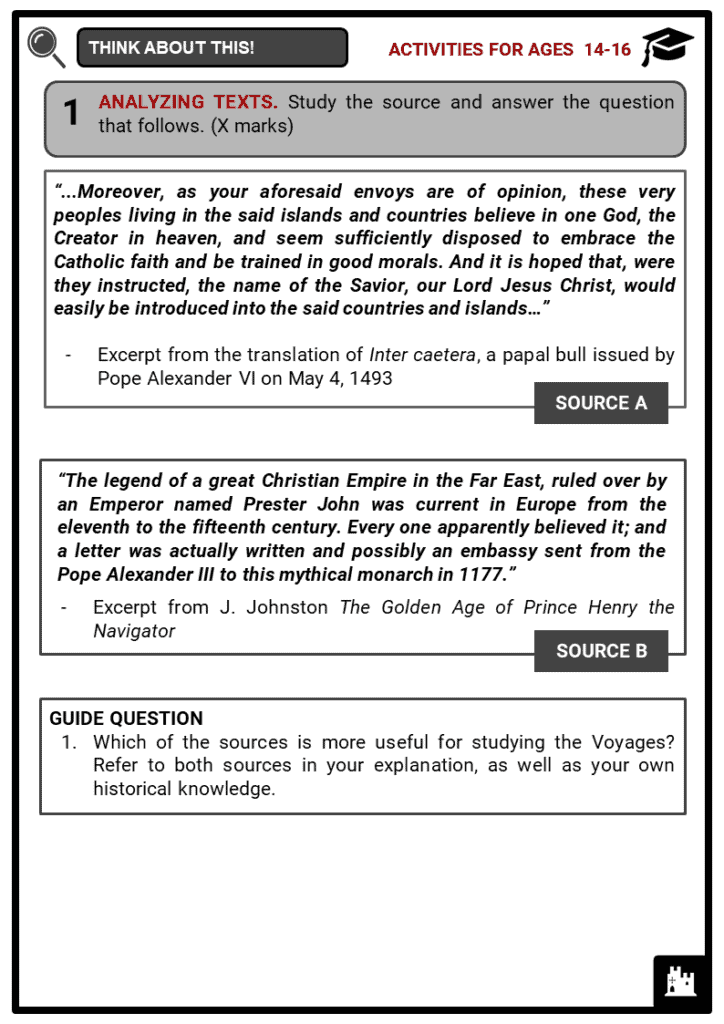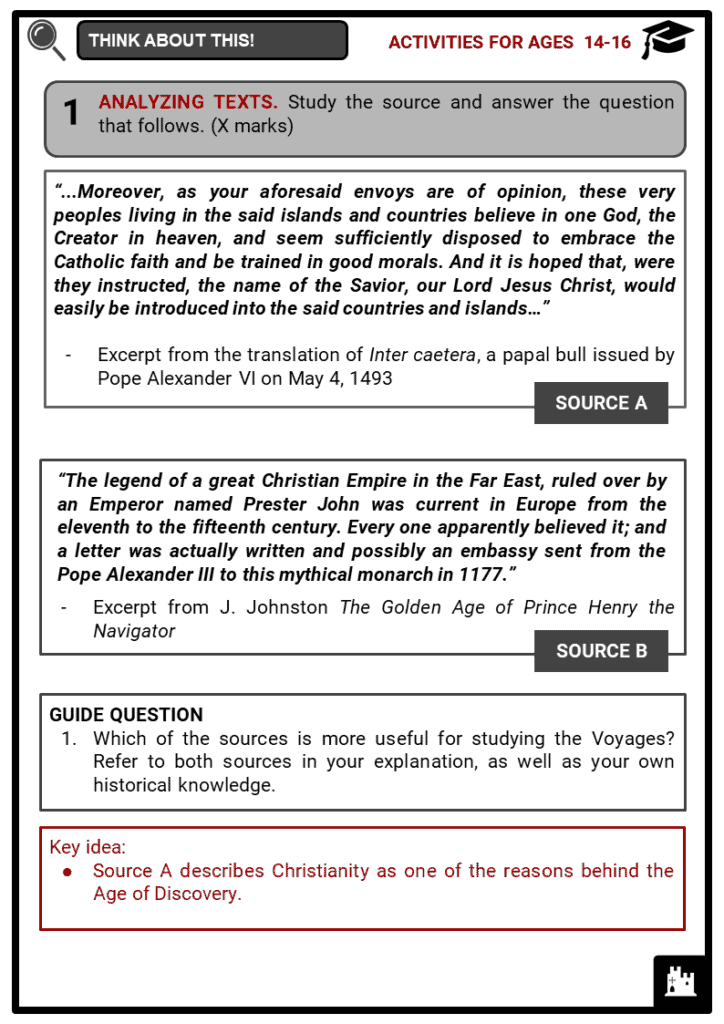Download Age of Discovery Worksheets
Do you want to save dozens of hours in time? Get your evenings and weekends back? Be able to teach Age of Discovery to your students?
Our worksheet bundle includes a fact file and printable worksheets and student activities. Perfect for both the classroom and homeschooling!
Summary
- The factors behind the emergence of the Age of Discovery
- Contest of exploration between European powers
- Journey of famous explorers
- Impacts of the Age of Discovery
Key Facts And Information
Let’s know more about Age of Discovery!
Human beings have an urge to discover, to explore, and to examine their geographical environment. To discover is to gain power. Great empires and kingdoms had various reasons to explore, such as pursuing trade, spreading religion, or obtaining political and economical power. Thus, many explorers were funded by their kingdoms when going in search of new lands and new routes for trade.
Birth of the Age of Discovery
- Since the first millennium AD, Europeans used the silk road, which encompassing the Eurasian continent, as a trade route.
- During this time, Europeans assumed that the Indian Ocean was an inland sea that connected Africa and Asia.
- During the reign of Alexander the Great, people in the West knew about India and believed that it was the home of all exotic wares entering Europe.
- The series of crusades between European Christians and Muslims, which ended in 1291, brought ship-building and trading influence to Europe.
- In 1453, the Ottoman Empire took control of Constantinople, which blocked trade routes going to North Africa, the Red Sea, and the Far East from Europeans. This meant that all trade needed to traverse through the Middle East (Byzantine Empire) and parts of Italy.
- Factors which led to the Age of Discovery/Exploration
- The Age of Discovery, which occurred between the early 15th century until the mid 17th century, was led by Spain and Portugal, both European powers in navigation.
POWER OF SPAIN AND PORTUGAL
- Both Spain and Portugal are located on the Iberian Peninsula, which is surrounded by water. Thus, the location of each nation inevitably encouraged maritime voyages.
- In 711 AD, the Iberian Peninsula was conquered by the Moors, giving them navigational advancements like cartography and ship-building.
- There was political unity among the Spanish and Portuguese kingdoms and their respective merchant class.
- Prince Henry was the third son of John I, King of Portugal, and he was widely credited for leading Portuguese exploration in the early 15th century.
- In the south of Portugal, he established a School of Navigation that taught sailors the systematic way of exploration.
- Between 1415 and 1456, Prince Henry participated in a series of discoveries for Portugal. He was part of the Portuguese conquest of Ceuta, the Madeira Islands, the Azore Islands, Cape Bojador, and the Cape Verde Islands.
- The Portuguese discovery missions of the west coast of Africa were numerous. Denis Dias, a Portuguese navigator, reached Senegal in 1445, and the rivers of Senegal were depicted by him to have been the richest on earth. In 1455 and 1456, Alvise Ca’ da Mosto sailed to Gambia and the Cape Verde Islands.
- The hope to reach the Indies by sailing along the coast of Africa soon evaporated, since the continents’ coast seemed to extend endlessly southwards. At that particular time, Columbus requested to sail west across the Atlantic to reach the Indies, but his request was declined.
- Pêro da Covilhã, a Portuguese explorer, followed the first route established by King John II. The first route is a land and sea route that paves the way through Egypt and Ethiopia to the Red Sea and the Indian Ocean.
- This route was found successful by Pêro da Covilhã, as he claimed that, to reach India, traders “could navigate by their coasts
- and the seas of Guinea.”
- The union of Aragon and Castile through the marriage of Ferdinand II and Isabella allowed Spain to compete with its neighbor in the late 15th century.
- The marriage united all dominions of Spain, which elevated its status as a nation.
- In 1492, they introduced the Spanish Inquisition, which resulted in the reconquest of Granada from the Moors and the conversion of Spanish Muslims and Jews to Christianity. In the same year, they were given the title ‘Catholic Monarchs’.
- In 1495, they succeeded in capturing the Canary Islands from their rival, Portugal.
SEARCH FOR NEW TRADE ROUTES TO ASIA
- At the end of the Crusades, crusaders went back to Europe with a great variety of goods from Africa, the Middle East, and Asia.
- After the crusades, Muslims and Italians controlled trading in the Mediterranean. In response, monarchs and merchants in Europe wanted to break this control.
- As a result, Europeans’ desire for trade increased. However, with Muslim control of trade routes, they found trading of goods expensive and difficult.
- They financed and supported voyages to find new trade routes to Asia without traversing through the Mediterranean.
SPREAD OF CHRISTIANITY
- After the Crusades, Christian Europeans had the desire to spread Christianity in unknown parts of the world through missionaries traveling with explorers.
- Following the failure of the Crusades, Christians saw the redemption of believers against the Muslims.
TECHNOLOGICAL ADVANCES
- Cartography
- The art of mapmaking flourished in the 1500s. Gerardus Mercator, a Renaissance geographer, created maps using longitude and latitude.
- Ship-building
- By the 1400s, Portuguese and Spanish shipbuilders made caravels, light sailing ships that were easier to maneuver even in the coastlines.
- Weaponry
- Fusing influence from the Chinese and the Muslims, explorers were equipped with guns, cannons, armor, and horses.
- Navigational tools
- By the end of the 15th century, sailors used an improved compass that could figure out distance north or south of the equator.
The Contest for Discovery: European Powers and Explorers
Bartholomew Diaz and the coast of Africa
- Raised in a noble family, Bartholomew Diaz worked in the Portuguese royal court. He was credited as the first European explorer to set sail around Africa, which proved that the Atlantic Ocean was connected with the Indian Ocean.
- In August 1487, after a year of preparation, Diaz set sail from Lisbon accompanied by three ships.
- On December 8, he reached Namibia by traveling down the west coast of Africa. By December 26, he landed at Elizabeth Bay.
- Early in 1488, Diaz and his crew were carried away to the open waters by strong storms. For several days, they lost sight of the land, but Diaz decided to head north. On February 3, they landed on Mossel Bay, passing the southern tip of Africa.
Christopher Columbus & the Caribbean
- Columbus was born in Genoa, part of modern-day Italy. He owned a copy of Marco Polo’s book, which inspired him to pursue sailing and exploration. In the mid-15th century, while Portugal was at the height of discovering new trade routes to Asia, Columbus went to King John of Portugal for funding, but he was turned down.
- His request for funding from the monarchs of England and France were also declined.
- After seven years of looking for a patron to fund his voyage to Asia by sailing west, King Ferdinand and Queen Isabella of Spain sponsored Columbus with the help of Friar Juan Pèrez.
- On October 12, 1492, Columbus accidentally discovered the Caribbean Islands, which he believed to be the East Indies. He landed on the Bahamian island of Guanahani, which he named San Salvador. With the help of local Indians, Columbus reached Cuba and Haiti.
- Columbus led three ships, the Pinta, Niña, and Santa Maria, on his first voyage.
- He made a second voyage, as well as a third voyage, in which he entered the Gulf of Paria on the coast of what is now Venezuela.
- From 1502 to 1504, he made a fourth voyage and discovered the coast of Central America from Darien on the Isthmus of Panama to Honduras. However, he still believed that he reached Asia.
Columbian Exchange
- Immediately following the discoveries of Columbus, about 1,200 European settlers and a variety of goods were brought to the Caribbean. Europeans transported goods, including bananas, citrus fruits, coffee beans, onions, rice, pigs, sugarcane, wheat, horses, cattle, and chickens. In return, they acquired goods like beans, cacao, peanuts, pineapples, potatoes, pumpkins, tobacco, tomatoes, and turkeys.
- To resolve the claims of both Portugal and Spain over the Moluccas, commonly known as the Spice Islands, they agreed on the Treaty of Tordesillas, which was revised through the Treaty of Saragossa. This divided the world with a line of demarcation.
Amerigo Vespucci and naming America
- Due to his excellent educational background, Amerigo Vespucci was fluent in several languages and showed interest in astronomy, cartography, and navigation. He was the explorer who actually confirmed that the “New World” discovered by Columbus was a separate continent and not Asia.
- On May 18, 1499, Vespucci boarded his first voyage with 2 to 4 ships.
- The captain of the expedition was Alonso Ojeda, while Juan de la Cosa served as the pilot.
- From Cadiz, Spain, the team sailed from the west coast of Africa. They crossed the Atlantic for 24 days and arrived in Guiana in South America.
- He was confident that what he explored was not part of Asia or India, but rather a different continent. Eventually, the continent of the New World was named after him.
John Cabot and the Newfoundland
- Born as Giovanni Caboto, John Cabot was a Venetian explorer who claimed land in Canada (Newfoundland) for England.
- In May 1497, he sailed from Bristol and mistook Canada as part of Asia. Nonetheless, he claimed the North American land for the English king, Henry VII.
- After the Vikings, Cabot was known to be the next explorer that reached the Newfoundland.
- Similar to Columbus, Cabot thought that sailing west from Europe was a shorter route to Asia. With 18 men and a ship named Matthew, Cabot landed on the east coast of North America after 50 days of voyage.
- Until today, Cabot’s precise landing point is subject to debate. Some believed that he landed at Cape Breton Island or mainland Nova Scotia. Others argued that he landed at Newfoundland.
Vasco da Gama and India
- Vasco da Gama was a son of a knight and a noble woman. In addition to a good education, da Gama learned navigation while living near the seaport.
- He was the first European to reach India via the sea. His voyage linked Europe and Asia by traversing the Atlantic and Indian Oceans.
- On July 8, 1497, da Gama led an expedition to India by sailing around the coast of Africa.
- He led a fleet of four ships and 170 men with the flagship, São Gabriel, which was built by Bartholomew Diaz. In January 1498, they reached the River of Good Omens, where he erected a statue in the name of Portugal. After 23 days, they reached India and immediately met the king of Calicut.
Juan Ponce de Leon and Florida
- Born in Leon, Spain, Juan Ponce de Leon was born in nobility and served in the royal court of Aragon. In 1493, he joined Columbus on his second voyage. After a decade, he was rewarded with the governorship of the eastern province of Hispaniola by Nicolas de Ovando.
- Between 1508 and 1509, de Leon explored the nearby island of Puerto Rico in search of gold.
- In addition to rumors of gold, de Leon searched for the ‘fountain of youth’ and landed on the coast of Florida, near present-day St. Augustine.
Hernan Cortes and Mexico
- Hernan Cortes was a Spanish conquistador who was born in western Spain. He sailed to Santo Domingo to seek fortune in 1504 and settled in the town of Azúa, where he worked as a notary for years. He led an expedition that overthrew the Aztec Empire and colonized Mexico under the Spanish Crown.
- Originally part of Diego Velazquez’s fleet, Cortes organized his own expedition in inland Central America .
- On March 24, 1519, Cortes won his battle against the Maya of Potochan. As a gift, Cortes received gifts and a slave woman named Malinche, who would later become his interpreter.
- By July 26, he sent a treasure ship and a letter to Spain about the vast gold in Mexico.
Ferdinand Magellan and the search for Spice Island
- Ferdinand Magellan was born in a noble family. He worked in the royal court for the queen of Portugal and learned skills in fighting, shipping, and astronomy. He initially served as a soldier under King Manuel I, when Portugal tried to break Muslim power in India and Africa in 1505.
- He was the first European to cross the Pacific Ocean. Despite being killed in the Philippines, Magellan was known for leading the expedition that circumnavigated the world.
- In 1506, Magellan joined an expedition to the East Indies for the Spice Island, or Molucca. During that time, Magellan believed that he could reach Molucca by sailing West.
- His petition to King Manuel to sponsor his voyage was declined three times. As a result, he went to King Charles I of Spain and was granted the funds for his voyage.
- On September 20, 1519, two years after his arrival in Seville, Magellan set sail with 5 ships and around 200 men under his command. The ships were Trinidad, San Antonio, Concepción, Victoria, and Santiago.
- The passage at the tip of South America was named the Strait of Magellan. Moreover, he called the Sea of the South the Pacific Ocean.
- After 99 days at sea, Magellan and his crew ate fresh food when they reached Guam. They continued to sail west in search of the Spice Island.
- In March 1521, they reached the Philippine Islands and successfully converted and baptized a chief’s family into Christianity. Moreover, they successfully made contact with the natives.
- However, a chief named Lapu Lapu from Mactan rejected conversion to Christianity. Magellan and his 60 men attacked Mactan, and Magellan was killed in the battle on April 27.
- After Magellan’s death, Trinidad and Victoria continued to sail and eventually reached the Spice Islands.
- Due to damage to Trinidad, Victoria sailed back to Spain, captained by Sebastian Elcano. It crossed the Indian Ocean and passed the Cape of Good Hope. After nine months at sea, Victoria arrived in Spain on September 6, 1522, with only 18 surviving men.
Samuel de Champlain and Quebec
- Samuel de Champlain was a French explorer and cartographer known for discovering and mapping the St. Lawrence River, the Great Lakes, and the settlement of Quebec.
- Due to his travels along the Atlantic coast of Canada, Champlain became known as the Father of New France.
- In 1608, he founded a French settlement called Quebec. Moreover, he was also credited for helping in the foundation of French colonies in Acadia and Trois-Rivieres.
Impacts of the Age of Discovery
- The emergence of the Age of Discovery between the 15th and 17th century led the world to transformative changes and brought an era of interconnectedness. This era in history impacted the world through the following:
COLUMBIAN EXCHANGE
- Named after Christopher Columbus, his exploration in Hispaniola created the exchange of goods, animal species, and people between the New and the Old World. It later gave way to the transatlantic slave trade.
DECLINE OF NATIVE POPULATION
- Particularly in North and South America, European exploration and conquest caused deaths and eventual decline of indigenous populations. Also, along with goods, Europeans brought diseases to the New World.
- The most infamous epidemic was brought by Hernan Cortes and his crew to the Aztec Empire, which contributed to the decline of the Mesoamerican civilization.
MASS MIGRATION
- Upon exploring the New World, people began to migrate and establish settlements known as colonies. A large part of the founding of colonies took place during the transatlantic slave trade.
CAPITALISM AND MERCANTILISM
- Due to colonization and change in international trading patterns, capitalism was introduced. During the Age of Exploration, investor merchants accumulated huge amounts of wealth in trade ventures. Moreover, cottage industries brought manufacturing to another level.
- Colonies were also gained for mother nations’ acquisition of gold, silver, and raw materials. Mercantilism, or a nation’s power based on wealth, became common among European monarchs.
SPREAD OF KNOWLEDGE
- Mapping was improved, as were navigation skills and equipment. Explorers gathered more information about Africa and the Americas, and they spread this knowledge across Europe

